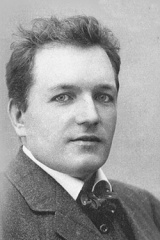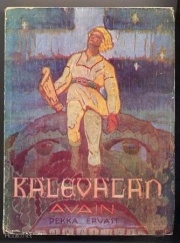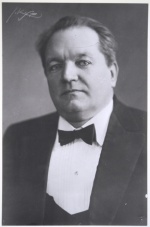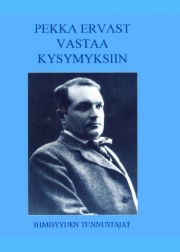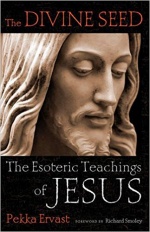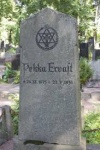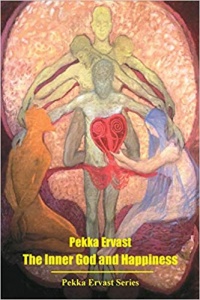Pekka Ervast
Pekka Ervast (1875-1934) was the founder of Finnish Section of Theosophical Society based in Adyar. He was a writer, lecturer, linguist, and clairvoyant.
Personal life
Pekka Ervast was born on December 26, 1875, in Helsinki, Finland. His mother tongue was Swedish, and he belonged to the Lutheran Church as the vast majority of Finns did at the time. His father was a public officer; Ervast’s mother died when he was eight years old. Beginning in childhood he had experiences of extrasensory perception. Even as a child, he was very versatile in languages: for instance, he learned to read French at the age of five or six, and at the age of twelve he began writing a comparative grammatical study of nine different languages.[1]
He passed his matriculation exams in 1893 and started studying romance languages and Sanskrit at the University of Helsinki, which was known by a different name then.
Theosophical Society involvement
In January 1894, Ervast got acquainted with Theosophy through a Swedish translation of Esoteric Buddhism by A. P. Sinnett:
I read a few sentences from the first chapter. There was talk about a brotherhood of adepts, how there has always been and still are human beings who have deeper knowledge about the secrets of nature and life than any scientist. I could read no more. I was overwhelmed by so great a shudder of joy that I was compelled to throw myself on the couch. My whole being sounded as in one voice: this is true, this is true...
The aftermath was so immense I could not read anything on that day. I couldn't think anything else. As if from a revelation I had gained a certainty that adepts do exist and a human being can participate in divine knowledge.[2]
The next year he joined the Scandinavian Section of the Theosophical Society. When the so-called Judge crisis broke in the United States, Ervast initially took the position of William Quan Judge in the dispute. The crisis in the Theosophical Society was painful to Ervast, who had believed in Universal Brotherhood, especially among theosophists.
Spiritual awakening
Earnestly seeking for the meaning of life took Ervast eventually to point where he said: now comes clarity or death. And then in the year 1896 he went through an experience of rebirth, in which he was transformed by a pure light. This experience formed the basis for his theosophical work.
On October 13, 1896, in the middle of the day, the agony of my soul had reached an utmost point...
There seemed to be a dark cloud before my eyes, and I felt as if my pain would transfer itself into the cloud. I then thought, such is life. At the same time the cloud tore apart as if struck by lightning, and the rays of the sun shone warmly on my face, bright but not dazzlingly. Gradually this lovely light surrounded me on every side, so I was as if in a sea of light, and eventually it filtered inside me, filled me, and lit me up totally, so I and my whole being became like a pure light...
My old life was wiped away...[3]
Universal Brotherhood and Theosophical Society
During the years 1896-1898, Ervast belonged to the Theosophical Society Point Loma, then named Universal Brotherhood or Universal Brotherhood and Theosophical Society. He was its representative in Finland. Later this branch of the Theosophical Movement was known for its colony in Point Loma, California.
He joined the esoteric school led by Mrs. Katherine Tingley. Ervast intensively followed meditation instructions of the esoteric school.
I got into a secret spiritual contact with people who regularly practiced meditation, and many of them could have had many spiritual and also psychic experience. As an esoterist I probably practiced more self-conscious and concentrated meditation than before, though I had always lived a contemplative life.[4]
After a while he was able to do conscious occult investigation and work in the invisible world. For instance, he was able to observe various states in the afterlife (a compilation of his teachings on this topic is available in English as the e-book From Death to Rebirth).
Theosophical Society, Adyar
In 1898, Ervast joined the Theosophical Society based in Adyar, Chennai, India. He corresponded with many of the main theosophical workers in his time. For instance, he met Society President Colonel Henry S. Olcott for the first time in 1900, and they got along very well. He also met the Countess Wachtmeister, who accompanied T.S. founder H. P. Blavatsky in her last years. The Countess warned Ervast not to enter politics in Finland.
Theosophical Society in Finland
Ervast started regular lecturing and writing on Theosophy early on in his theosophical career; theosophical work was his full-time occupation. It is worth noting that Theosophy in Finland attracted mainly persons belonging to the so-called working class, whereas in other parts of the Western world Theosophy was more popular among the higher classes. Ervast’s first book Towards Light (Valoa kohti) appeared in Finnish in 1901. It was an outline of a theosophical world view. The book is still in print, as are almost all his works which consist of more than 100 books (most of them are based on his lecture series). In addition, he translated theosophical books: C. W. Leadbeater’s The Other Side of Death appeared in Swedish in 1904 and Olcott’s Buddhist Catechism in Finnish in 1906. Ervast was also one of the translators of H. P. B’s The Key to the Theosophy and parts of The Secret Doctrine.
When the Theosophical Society in Finland was founded in 1907, Ervast was the first to serve as General Secretary, a position he held for ten years. The TS in Finland grew quickly into a vibrant organization. In 1911:
The Finnish Theosophical Society has officially existed only four years – it was founded October 21st, 1907 – but theosophical work has been done in our country unceasingly already for more than 16 years. The number of our lodges is to-day 19 and they have enrolled 407 members. Unattached members are to-day 170, altogether 577 members...
The propaganda work in Finland rests almost entirely upon the shoulders of our general secretary, Mr. Pekka Ervast, who for more than 10 years has indefatigably proclaimed the message of the ancient wisdom.... Everywhere his eloquence awakened much interest in Theosophy and newspapers recorded his lectures.[5]
In December, 1908, he had an accident in which he broke his foot. The journal Tietaja published an account of his experience:
He writes that at first his thoughts were about the sudden change in his life, the disability to work, etc. later, thoughts filled his heart with reverence and gratitude to the Masters who let this accident happen to him and believes it to be a great blessing and opportunity for him personally. Further, he thanks all those who have shown him so much love and sympathy and feels sure that the good thoughts directed to him have been most helpful, for he had no pain except the first night.[6]
At the Section's 1915 annual congress, 120 members attended. An oratorio was composed and presented by Axel von Kothen, and two plays written for the congress were presented to the public with an audience of 300.[7]
Ervast and other theosophists founded a commune Tuonenkylä in 1910. The commune offered a home for Ervast for thirteen years. Almost thirty people lived in the commune over the years it was owned by the Finnish T.S. The ideal of theosophists living together as an extended family is well and alive today in the Väinölä commune, in which Ervast’s teachings have the central role.
As with most organizations in the Theosophical Movement, publication of books and periodicals was an important activity of the T.S. in Finland. A magazine called Tietäjä was issued monthly. Evidently Mr. Ervast founded a joint-stock publishing company, which was taken over by the Finnish Section in 1922.[8]
Theosophy in wartime
The outbreak of the First World War in 1914 was a great disappointment for Ervast. He had believed that theosophists on both sides of the war would follow the ideal of the universal brotherhood and declined to go to war. Ervast was an unconditional pacifist: according to his interpretation, the non-resistance of evil is the cornerstone of Esoteric Christianity (this is well in line with ahimsa in Hinduism and Buddha’s teachings on non-violence).
Ervast published two of his main works during the war time: The Esoteric School of Jesus (the contemporary translation is called The Divine Seed) and The Key to the Kalevala, which is available in English as a free ebook. The former is a detailed investigation of the ethical teachings of Jesus from the perspective of Esoteric Christianity, and the latter is an exploration of the spiritual meaning of the Finnish National Epic, the Kalevala.
There were two different lines of thought among the Finnish theosophists: one side believed that the T. S. should directly participate in society to advance brotherhood in practice, whereas Ervast and some others felt that the T. S. should remain spiritual in nature. Naturally, members as citizens could be as active in society as they wished. These and other differences eventually caused Ervast to resign from the General Secretary post in 1917. In the same year Finland gained independency from Russia; Ervast had predicted this several years earlier. Unfortunately, next year the civil war broke in Finland which was a great sorrow for Ervast. He had believed that Finland could be the first country in the world which could live peacefully without weapons and army.
The Mission of the Theosophical Society
Ervast wrote a letter The Mission of the Theosophical Society – an open letter to Theosophists the world over, in 1921. The letter was aimed at all theosophical societies and called for a common platform which would serve as a fraternal meeting point for all who share the same theosophical ideals. However, it didn’t receive much attention from the theosophical world.
Order of the Star in the East
The Order of the Star in the East was under intense interest among the theosophists in Finland and elsewhere. However, Rudolf Steiner, who was the Head of the German Section of the T. S. at the time, was very critical towards teachings of Krishnamurti as a new World Teacher. Ervast was also critical, but he would have preferred that different opinions could have co-existed in the T. S. Ervast met Steiner when he visited Helsinki in a lecture tour in 1912 just before Steiner left the T. S.
Co-Freemasonry
The year 1920 brought changes in Ervast’s life. He joined the Universal Co-Freemasonry Le Droit Humain) and received the 33rd Degree Initiation in Paris five years later. Co-Freemasonry was very popular among the theosophists at the time, especially as T.S. President Annie Besant and several other prominent theosophical leaders had joined it.
Esoteric Christianity and Rosicrucianism
On November 14, 1920, Ervast founded a new society, The Finnish Rosy Cross (Ruusu-Risti) in the tradition of Rosicrucianism. The society has its roots both in Theosophy and Esoteric Christianity, in which the teachings of the Sermon on the Mount are crucial in the spiritual path. Ervast lectured on the special status of Jesus Christ in the spiritual evolution of humanity.[9] In some respects, his teaching on the Christ concur with Rudolf Steiner’s teachings. Naturally, all the great religions are highly valued as well. Ervast valued highly Leo Tolstoy’s interpretation on the Sermon on The Mount, and he never gave up the ethics of the Sermon on the Mount. Ervast did not, however, accept Tolstoy’s very critical view on art, nor Tolstoy’s appreciation of physical labor as only true form of work.
Gottfried de Purucker from the Theosophical Society in Point Loma visited Helsinki in 1931. He proposed that the Finnish Rosy Cross could join the Point Loma society. His proposal was not accepted, although the meeting in Helsinki was cordial.
Later years
Ervast remained prolific to the end of his life. For instance, he published the book The Sermon on the Mount (the Finnish version appeared in 1925) and the play H. P. B (The Sphinx of the Nineteenth Century) in 1933 in English. The book attracted several reviews in such periodicals as News and Notes (Sidney, by K. B.), The Occult Review (London, by Frank Lind) and The Aryan Path (Bombay, by Swami Jagadiswarananda). The play was reviewed in The Occult Review (by J. F. Lawrence).
Ervast spent the winter 1933-1934 in Ojai, California, home of the Krotona Institute of Theosophy and Jiddu Krishnamurti. He wrote his final book, The Great Adventure, in California. Ervast called the book his swan song. He came back to Finland in May 1934 and died on May 22, 1934 in Helsinki. The stone marking his grave was carved with the emblem of the Theosophical Society to which he had devoted his life.
Ervast had a significant impact on the Finnish cultural life: for instance, many artists received inspiration from his teachings. His legacy lives on in Finland within several groups dedicated to his teachings.
Writings in English
Pekka Ervast wrote over 100 books in several languages, and many have been translated into yet more languages. His works have been used for study groups in several countries.
His 1933 play The Sphinx of the Nineteenth Century drew attention in the Theosophical world. It was performed for a 1942 White Lotus Day performance at the Cleveland-Besant Lodge, depicting scenes from the life of Madame Blavatsky with Countess Wachtmeister, and G. R. S. Mead.[10] Similar performances were held in 1944 at the Olcott Lodge at Theosophical Society in America headquarters,[11] and in 1948 at the Pacific Lodge in San Francisco.[12]
- From Death to Rebirth. Literary Society of the Finnish Rosy Cross, 2017. Compiled and edited by Jouni Marjanen, Antti Savinainen, and Jouko Sorvali. Foreword by Richard Smoley. This is also available as an audio book.
- The Divine Seed: The Esoteric Teachings of Jesus. Second edition published by Quest Books, 2010. Reviewed in TheoSophia (NZ) 72.4 (Summer, 2011), 29.
- The Key to the Kalevala. 1916. The English version was first published in 1999 by Blue Dolphin Publishing and the e-book version in 2018 by Literary Society of the Finnish Rosy Cross.
- The Mission of the Theosophical Society. 1921.
- Astral Schools. 1929. The English e-book version was published in 2008 by the PekkaErvast.net website.
- The Sermon on the Mount. 1933.
- H. P. B.: The Sphinx of the XIXth Century. 1933.
- Spiritual Knowledge. Pekka Ervast Series Book 1. Helsinki: Aatma, 2018. Print and Kindle editions are available.
- The Inner God and Happiness. Pekka Ervast Series Book 2. Helsinki: Aatma, 2018. Print and Kindle editions are available.
- The Unseen Ecclesia. Pekka Ervast Series Book 3. Helsinki: Aatma, 2021.
- Overcoming Evil. Pekka Ervast Series Book 4. Helsinki: Aatma 2024.
Additional resources
- Ervast, Pekka. "Reports of the TS in Finland" The Theosophist v39 (July, 1918), 392.
- General Reports of the Theosophical Society provide reports written by Pekka Ervast during the years that he was leader of the Finnish Section of the TS Adyar.
- PekkaErvast.net. Website in Finnish.
- Marjanen, Jouni, Savinainen, Antti, and Sorvali, Jouko, compilers and editors. From Death to Rebirth: Teachings of the Finnish Sage Pekka Ervast. Literary Society of the Finnish Rosy Cross, 2017. Foreword by Richard Smoley.
- Savinainen, Antti. Exploring the Rich Esoteric heritage of Finland. Interview by Richard Smoley. Presented March 30, 2023 at the Theosophical Society in America.
- Koskinen, Matti, and Rinkinen,Rauno. "Pekka Ervast’s Spiritual Heritage" in Hermes Risen online magazine. Translated by Antti Savinainen, edited by Richard Smoley. 2023
Notes
- ↑ Information in this article, if otherwise unattributed, was provided by Dr. Antti Savinainen, a Finnish Theosophist and educator, to whom the wiki editors are most grateful.
- ↑ Jouni Marjanen, Antti Savinainen, and Jouko Sorvali, "Pekka Ervast's Path to Spiritual Knowledge" From Death to Rebirth: Teachings of the Finnish Sage Pekka Ervast (Literary Society of the Finnish Rosy Cross, 2017), 18.
- ↑ Marjanen, Savinainen, and Sorvali, 21.
- ↑ Marjanen, Savinainen, and Sorvali, 24.
- ↑ T. V., "Theosophy in Finland" The Theosophic Messenger 13.1 (Oct 1911), 26.
- ↑ Tietaja January, 1909. Mentioned in The Theosophic Messenger 10 no10 (July, 1909): 473.
- ↑ V. H. Valvanne,"The Annual Congress of the Finnish Section" The Messenger 3.5 (Oct 1915), 148.
- ↑ John Sonck, "T. S. in Finland" General Report of the Theosophical Society 1922 (Adyar, Madras, India: Theosophical Publishing Company, 1922), 96-97.
- ↑ One e-book addressing this topic to some extent is available.
- ↑ Anonymous, "Theosophy in the Field" The American Theosophist 30.7 (July, 1942), 164.
- ↑ Anonymous, "Theosophy in the Field" The American Theosophist 32.6 (June, 1944), 139.
- ↑ Anonymous, "Theosophy in the Field" The American Theosophist 36.6 (June, 1948), 138.
